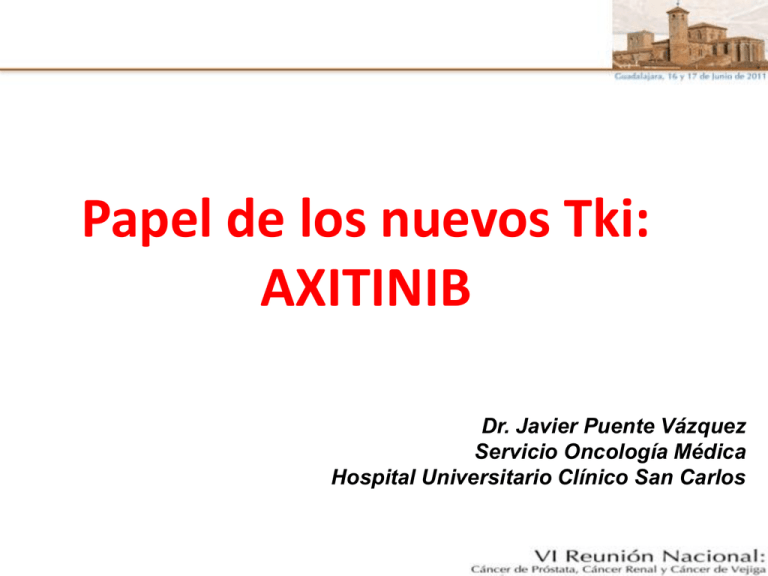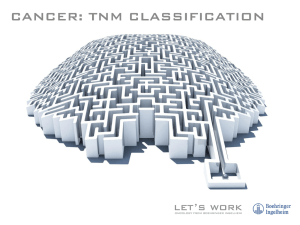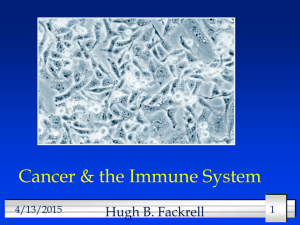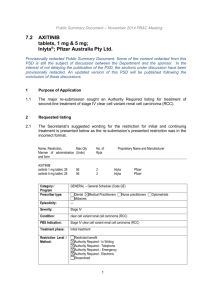Axitinib Reduces Tumour Growth
advertisement

Papel de los nuevos Tki: AXITINIB Dr. Javier Puente Vázquez Servicio Oncología Médica Hospital Universitario Clínico San Carlos The challenge of treatment in mRCC • Benefits of tyrosine kinase inhibitors (TKIs) are well established; however, there are limitations – There are few complete responses – Initial partial responses are followed by progression – In other cases there is no objective benefit • Drug resistance remains an ongoing obstacle to successful treatment of mRCC – Limits the success of therapy and reduces survival rates Motzer RJ, et al. J Clin Oncol 2009; Rini B, et al. J Clin Oncol 2010; Escudier B, et al. J Clin Oncol 2010; Escudier B, et al. N Engl J Med 2007; Hudes G, N Engl J Med 2007 Patterns of tumor progression on VEGF or VEGFR inhibitors Late progressors Change in Tumor Measurements (%) Group A Early progressors Change in Tumor Measurements (%) Change in Tumor Measurements (%) Primary refractory Group B Group C Targeted therapy in mRCC: mechanisms of resistance Group A Group B-C TTP > 6 months. TKI´s sensitive Cont. VEGFr inhibitors ? TTP < 6 months. TKI´s resistance Switch to mTOR inhibitors ? Inhibiting VEGF Receptors 1, 2, 3 Axitinib is an Oral, Potent, and Highly Selective Inhibitor of VEGF Receptors 1, 2, 3 • Small molecule indazole derivative • Orally administered: 5 mg BID ● 5 mg Film Coated Tablet Axitinib N CONHMe S H N N BID = twice daily Hu-Lowe DD, et al. Clin Cancer Res. 2008;14:7272–7283. Disrupting Tumour Progression Axitinib comprehensively disrupts tumour progression by inhibiting the VEGF receptor signalling system. PIGF VEGF C VEGF A VEGF B Axitinib VEGF D VEGFR 2 VEGFR 1 Tumour Growth via Vascular Angiogenesis Tumour Cell Proliferation Ellis LM, Hicklin DJ. Nat Rev Cancer. 2008;8:579–591. VEGFR 3 Tumour Spread via Metastatic Tumour Colonisation via Lymphangiogenesis Axitinib is a Selective Inhibitor of VEGF Receptors 1, 2, 3 Selective Inhibitor • Low IC50 indicates higher affinity. • Axitinib inhibits VEGF receptors 1, 2, and 3 at picomolar concentrations, suggesting potent and highly selective activity against these receptors. Hu-Lowe DD, et al. Clin Can Res. 2008;14:7272–7283. Receptors RTK Cellular IC50 (nM) VEGFR-1 0.1* VEGFR-2 0.2 VEGFR-3 0.1–0.3 PDGFR-α 5.0 PDGFR-β 1.6 KIT 1.7 CSF-1R 73 FGFR-1 231 FLT3 >1000 RET >1000 Axitinib is More Potent Than Most VEGF Receptor Kinase Inhibitors 1,000 100 Potency: IC50 (nM) Less potent More potent VEGFR-1 VEGFR-2 VEGFR-3 10 1 0.1 AV-951 Axitinib Cediranib Motesanib Sunitinib AMG-706 ABT-869 Pazopanib Sorafenib Vatalanib Vandetanib PTK787 0.01 Figure modified using data from: Chow LQM, Eckhardt SG. J Clin Oncol. 2007;25:884–896; Eskens FALM, et al. Proceedings of the 99th Annual Meeting of the American Association for Cancer Research. 2008. Abstract LB-201; and Hu-Lowe DD, et al. Clin Cancer Res 2008;14:7272-7283 Decreasing VEGFR-2 in Animal Models Axitinib Decreases VEGFR-2 in Animal Models • Blockade of VEGFR-2 may lead to a decrease in MVD and blood flow. • Significant reductions in intensity of VEGFR-2 and VEGFR-3 of RIP-Tag2† tumour vessels after 7 days of axitinib treatment Axitinib 7 days Vehicle Axitinib 7 days *Different from corresponding vehicle (P< 0.05) †The RIP-Tag2 animal model is of pancreatic islet cell cancer. MVD = microvessel density Inai T, McDonald D. J Am Pathol. 2004;165:35–52. Olsson AK, et al. Molec Cell Biol. 2006;7:359–371. Reduces Tumour Blood Vessels Axitinib Reduces the Number of Tumour Blood Vessels • Axitinib reduced MVD and normalised tumour vasculature in 7 days – Withdrawal resulted in regrowth of vessels. CD31 Untreated Axitinib 7 days RIP-Tag2 Mancuso MR, et al. J Clin Invest. 2006;116:2610–2621. Withdrawal 2 days Withdrawal 7 days Decreasing Tumour Blood Flow Axitinib Decreases Tumour Blood Flow • Axitinib rapidly decreases tumour blood vessel patency, blood flow, and vessel number within 24 hours of exposure. Vehicle Reduction of Flow Reduction of Angiogenic Vessels Overlay Inai T, McDonald D. J Am Pathol. 2004;165:35–52 Axitinib 1 Day Axitinib Blocks Vascular Sprouting in Animal Models Vascular Sprouting Untreated • Vascular sprouting is one of the initial processes associated with angiogenesis. Axitinib 7 days • Axitinib effectively blocks vascular sprouting. Tammela T, et al. Nature. 2008;454:656–660; Inai T, McDonald D. J Am Pathol. 2004;165:35–52. Axitinib Reduces Tumour Growth Reduction in Vascular Permeability • Axitinib decreased vascular permeability after 7 days. KPS (mL/100 g/min) Color 1 maps of Kps values 2 in the central tumour1slice Control Control Axitinib Axitinib 2 0.100 0.075 0.050 0.025 0.010 Baseline 7 days post-treatment MRI = magnetic resonance imaging; Kps = tumour endothelial transfer coefficient Wilmes LJ, et al. Magn Reson Imaging. 2007;25:319–327. Axitinib Reduces Tumour Growth Reduction in Tumour Volume • Axitinib reduced tumour volume in mice. 400 300 (mm3) MRI enhanced tumour measurements showed significant decreases in tumour volume for the axitinib vs. control group. Mean volume change after 7 days + 213 mm3 Control Axitinib 200 100 - 160 mm3 0 –100 –200 MRI = magnetic resonance imaging; Kps = tumour endothelial transfer coefficient Wilmes LJ, et al. Magn Reson Imaging. 2007;25:319–327. -RR: 44.2% -TTP: 15.7 meses -SG: 29.9 meses Motzer, et al. ASCO 2011 Motzer, et al. ASCO 2011 Reflexiones ASPECTOS POSITIVOS • Estudio Fase III randomizado. • Estudio PURO de 2ª línea. • Mediana PFS: 6.7 meses • TR: 19% • Tolerancia similar Tki • Baja tasa de discontinuación ASPECTOS ???? • 45% de los pacientes no recibieron sunitinib. • En pre-Sunit, PFS: 4.8 meses • ¿Porqué tanta discrepancia entre IRC e investigadores? • ¿Porqué dar la opción de incrementar la dosis? Conclusiones - Axitinib es un nuevo inhibidor de tirosina quinasa de alto poder inhibitorio sobre VEGFR 1, 2 y 3. - En el contexto de la segunda línea, y en comparación con sorafenib, prolonga la SLP de forma significativa. - Axitinib presenta un perfil de tolerabilidad semejante a otros Tki (hipertensión, hipotiroidismo) pero, en comparación con sorafenib, presenta menos SMP, rash y alopecia. - Axitinib se postula como una alterantiva terapéutica en el contexto de la segunda línea del CCRm.









